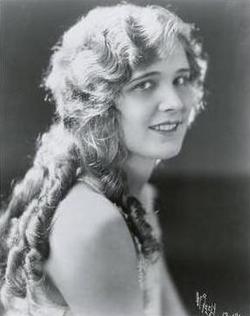Marilyn Miller (Mary Ellen Reynolds)

Marilyn Miller appeared for the Shuberts in the 1914 and 1915 editions of The Passing Show, a Broadway revue at the Winter Garden Theatre, as well as in The Show of Wonders (1916) and Fancy Free (1918). But it was Florenz Ziegfeld who made her a star after she performed in his Ziegfeld Follies of 1918, at the famed New Amsterdam Theatre on 42nd Street, with music by Irving Berlin. Sharing billing with Eddie Cantor, Will Rogers and W. C. Fields, she brought the house down with her impersonation of Ziegfeld’s wife, Billie Burke, in a number entitled Mine Was a Marriage of Convenience. She followed as a headliner in the Follies of 1919, dancing to Berlin’s “Mandy”, and reputedly became Ziegfeld’s mistress, though this was never proven. Miller attained legendary status in the Ziegfeld production Sally (1920) with music by Jerome Kern, especially for her performance of Kern’s “Look for the Silver Lining”. After a rift with Ziegfeld, she signed with rival producer Charles Dillingham and starred as Peter Pan in a 1924 Broadway revival, then as a circus queen in Sunny (1925), with music by Kern and lyrics by Oscar Hammerstein. A box-office smash, it featured the classic Who?, and made her the highest paid star on Broadway. In 1928, after reuniting with Ziegfeld, she starred in his production of the successful George Gershwin musical Rosalie then in Smiles (1930) with Fred Astaire, a rare Ziegfeld box office failure. Marilyn Miller’s movie career was short-lived and less successful than her stage career. She made only three films: adaptations of Sally (1929); and Sunny (1930); and Her Majesty Love (1931), with W. C. Fields. Her last Broadway show, marking a major comeback, was the innovative 1933-34 Irving Berlin/Moss Hart musical, As Thousands Cheer, in which she appeared in the production number, “Easter Parade”.
As it turned out, Marilyn Miller’s appearance in As Thousands Cheer was her last professional outing. Marilyn Miller quit the show after her boyfriend and future husband Chester O’Brien (a chorus dancer who served as the production’s second assistant stage manager) was fired for allowing the Woolworth department store heir Jimmy Donahue to sneak onstage during a scene in which the actress was impersonating Donahue’s cousin, the heiress Barbara Hutton. After Miller’s death, this incident gave Irving Berlin the inspiration for a film musical, On the Avenue, for which he received a script credit in addition to writing the songs. At the time of her death, Miller was described as having been in retirement. Marilyn Miller had a long history of sinus infections, and her health was compromised by an increasing dependency on alcohol. According to reports shortly before her death, she entered a New York hospital in early March 1936 in order to recover from a nervous breakdown. Three weeks after she entered the hospital, however, she developed a toxic condition and died from complications following surgery on her nasal passages. She was 37. She died in New York City on the morning of April 7, 1936 and was given a funeral at Saint Bartholomew Church on Park Avenue which drew 2,500 people, including former mayor Jimmy Walker, Beatrice Lillie, and Billie Burke. The procession led to Woodlawn Cemetery in the Bronx, where Miller was buried alongside her first husband, Frank Carter, in a mausoleum she had constructed to house his remains.
Born
- September, 01, 1898
- USA
- Evansville, Indiana
Died
- April, 07, 1936
- USA
- New York, New York
Cause of Death
- complications of surgery
Cemetery
- Woodlawn Cemetery
- Bronx, New York
- USA



